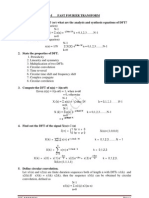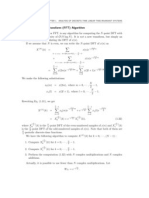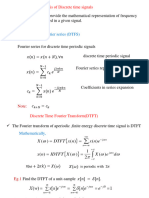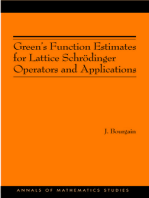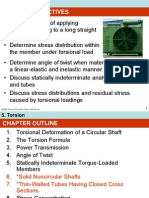Computation of DFT
Computation of DFT
Uploaded by
hakkem bCopyright:
Available Formats
Computation of DFT
Computation of DFT
Uploaded by
hakkem bOriginal Title
Copyright
Available Formats
Share this document
Did you find this document useful?
Is this content inappropriate?
Copyright:
Available Formats
Computation of DFT
Computation of DFT
Uploaded by
hakkem bCopyright:
Available Formats
DSP (2007)
Computation of DFT
Computation of DFT
Efficient algorithms for computing DFT Fast Fourier Transform. (a) Compute only a few points out of all N points (b) Compute all N points What are the efficiency criteria? Number of multiplications Number of additions Chip area in VLSI implementation
DFT as a Linear Transformation
Matrix representation of DFT Definition of DFT:
X (k ) = x(n) = 1 N
N 1
n =0 N 1 k =0
x(n)WNkn , X (k )WNkn ,
k = 0,1, K, N 1 n = 0,1, K, N 1
where
X ( 0) x (0) X (1) Let x (1) , , XN = xN = M M X ( N 1) x ( N 1)
and
1 1 1 W N 2 WN = 1 W N M M ( N 1) 1 W N 1 W W W
2 N 4 N
2 ( N 1) N
2 ( N 1) L WN L M ( N 1)( N 1) L WN L L 1
N 1 WN
Thus,
X N = WN x N xN = W XN 1 * = WN XN N
1 N
N - point DFT N - point IDFT
k Because the matrix (transformation) WN has a specific structure and because WN has par-
ticular values (for some k and n), we can reduce the number of arithmetic operations for computing this transform.
NCTU EE
DSP (2007)
Computation of DFT
Example
x[n ] = [0 1 2 3]
W40 W40 0 W W41 W4 = 40 W4 W42 0 3 W4 W4
1 1 W40 W40 1 1 1 2 3 2 3 W4 W4 1 W4 W4 W4 = 2 0 2 W44 W46 1 W4 W4 W4 3 2 1 W46 W49 1 W4 W4 W4 1 1 1 1 1 j 1 j = 1 1 1 1 1 j 1 j
Only additions are needed to compute this specific transform. (This is a well-known radix-4 FFT) Thus, the DFT of x[n ] is
6 2 + 2 j X 4 = W4 x 4 = 2 2 2 j
Fast Fourier Transform
-- Highly efficient algorithms for computing DFT General principle: Divide-and-conquer
k Specific properties of WN
kn kn * Complex conjugate symmetry: WN = (WN )
k+N 2 = W k Symmetry: WN N
k+N k Periodicity: WN = WN
Particular values of k and n: e.g., radix-4 FFT (no multiplications) Direct computation of DFT
X [k ] = =
N 1 n =0 N 1 n =0
x[n] WNkn ,
[Re(x[n]) Re(W ) Im(x[n]) Im(W )] + j[Re( x[n]) Im(W ) + Im( x[n])Re(W )]
kn N kn N kn N kn N
k = 0,1, K , N 1
For each k, we need N complex multiplications and N-1 complex additions. 4N real multiplications and 4N-2 real additions. We will show how to use the properties of WN to reduce computations. Radix-2 algorithms: Decimation-in-time; Decimation-in-frequency Composite N algorithms: Cooley-Tukey; Prime factor Winograd algorithm Chirp transform algorithm
k
NCTU EE
DSP (2007)
Computation of DFT
Radix-2 Decimation-in-time Algorithms
-- Assume N-point DFT and N = 2 Idea: N-point DFT N
-point DFT N
-point DFT
N -point DFT 4
N -point DFT N -point DFT 2 4
N -point DFT 4
Sequence: x[0] x[1] x[2] x[3] L Even index: x[0] x[2] Odd index: x[1] x[3]
X [k ] =
N 1
x[n ] L x[ N 1] 2
L x[ N 1]
L x[ N 2 ]
x[n]WNkn , k = 0,1,K, N 1 n =0 kn kn = x[n ]WN + x[n ]WN
n even N 1 2 r =0
14243
n =2 r
n odd
14243
n =2 r +1 N 1 2 r =0
x[2r ]WN2 rk + x[2r + 1]WN( 2 r+1) k
2 N 2 2 j N
QW = e
N 1 2
=e
2 j N /2
= WN / 2
rk k rk X [k ]= x[2r ]WN / 2 + WN x[ 2 r + 1]WN / 2 r= =04 0 4 1r 4 244 3 14 4 2444 3 N -point DFT 2 N -point DFT 2
N 1 2
k = G[ k ] + W N H [k ]
NCTU EE
DSP (2007)
Computation of DFT
Comparison: (a) Direct computation of N-point DFT (N frequency samples): ~ N 2 complex multiplications and N 2 complex adds (b) Direct computation of N -point DFT: 2 ~ N complex multiplications and N complex adds
2 2
2 2
+ additional
complex multis and
2 2
complex adds
~ (Total:) N + 2 N = N + N complex multis and adds 2 2 (c) log 2 N -stage FFT Since N = 2 , we can further break N -point DFT into two N -point DFT and
so on.
At each stage: ~
complex multis and adds
Total: ~ N log 2 N complex multis and adds (--> N log N ) 2 2
NCTU EE
DSP (2007)
Computation of DFT
Number of points, N 4 8 16 64 256 1024
Direct Computation: Complex Multis 16 64 256 4,096 65,536 1,048,576
FFT: Complex Multis 4 12 32 192 1,024 5,120
Speed Improvement Factor 4.0 5.3 8 21.3 64.0 204.8
Butterfly: Basic unit in FFT Two multiplications:
One multiplication:
NCTU EE
DSP (2007)
Computation of DFT
In-place computations Only two registers are needed for computing a butterfly unit.
r X m [ p ] = X m 1 [ p ] + W N X m 1 [ q] r X m [ q] = X m 1 [ p ] W N X m 1 [ q ]
Advantage: less storage! In order to retain the in-place computation property, the input data are accessed in the bit-reversed order. Note: The outputs are in the normal order (same as the position) Binary equivalent Bit reversed 6 110 011 2 010 010 Remark: Index 3 input data is placed at position 6. Position Sequence index 3 2
We may also place the inputs in the normal order; then the outputs are in the bit-reversed order.
NCTU EE
DSP (2007)
Computation of DFT
If we try to maintain the normal order of both inputs and outputs, then in-place computation structure is destroyed.
NCTU EE
DSP (2007)
Computation of DFT
Radix-2 Decimation-in-frequency Algorithms
Dividing the output sequence X [k ] into smaller pieces.
X (k ) =
N 1 n =0
x( n )W Nkn ,
k = 0,1,K , N 1
If k is even,
X [2 r ] = =
N 1 n =0 N 1 2 n =0
k = 2r .
r = 0,1, L ,
N 1
x[n ]WNkn ,
N 1 2 n (n + N ) 2
N
2 nr x[n ]WN x[n ]WN2nr + N n= 2 N 1 2
2 r n+ N = x[n ]W + x n + WN 2 2 n =0 n =0 2 r[ n+ N ] 2 rn 2 rn rN 2 Q WN = WN WN = WN 2 nr N
N 1 2
= =
N 1 2
n =0 N 1 2 n =0
n+ x[n ] + x n+ x[n ] + x
N 2 nr WN 2 N nr WN 2 2
Similarly, if k is odd,
X [2 r + 1] =
N 1 2 n =0
k = 2r + 1 .
N n nr WN WN 2 2
N nr WN 2 2 N n nr WN WN 2 2
x[n] x n +
N 1 2 n =0 N 1 2 n =0
X [2r ] = X [2r + 1] =
n+ x[n] + x n+ x[n] x
Let g[n ] = x[n ] + x n + 2
N h[n ] = x[n ] x n + 2
NCTU EE
DSP (2007)
Computation of DFT
We can further break X [2r ] into even and odd groups Again, we can reduce the two-multiplication butterfly into one multiplication. Hence, the computational complexity is bout N log N . The in-place computation property holds if the 2
2
outputs are in bit-reversed order (when inputs are in the normal order).
NCTU EE
DSP (2007)
Computation of DFT
FFT for Composite N
-- Cooley-Tukey Algorithm: N = N 1 N 2
Time index : n = N 2 n1 + n2 Freq. index : k = k1 + N 1k 2 0 n1 N 1 1 0 n2 N 2 1 0 k1 N 1 1 0 k 2 N 2 1
Remark: n ( n1 , n2 ) and k ( k1 , k 2 )
Goal: Decompose N-point DFT into two stages:
N 1 -point DFT N 2 -point DFT
X [k ] =
N 1 n =0
x[n]WNkn ,
0 k N 1
= X [k1 + N 1k 2 ] = =
N 2 1 N1 1 n2 =0 n1 =0 N 2 1 N1 1 n2 =0 n1 =0
x[ N 2 n1 + n2 ] WN(k + N k )( N n +n )
1 1 2 2 1 2
N kn W k n x[ N 2 n1 + n2 ] W N 1 23 N
2 1 1 k1n1 WN 1
1 2
N1N 2k2n1 k1N1n2 WN WN 123 1 4 24 3
k 2 n2 WN 2
k1n1 k1n2 k2n2 W = x[ N 2 n1 + n2 ] WN N3 WN 2 1 1 2 n2 =0 n1 =0 twiddle 1444 4 24444 3 factor N point 44444 44 1 14 44 2444444 3
N 2 1 N1 1 N 2 -point
Procedure (1) Compute
G[n2 , k1 ] =
N 1 -point DFT: (row transform)
N1 1 n1 =0
x[ N 2 n1 + n2 ] WNk n
1 1 1
(2) Multiply twiddle factors:
~ k1n2 G[n2 , k1 ] = WN G[n2 , k1 ]
(3) Compute
N 2 -point DFT: (column transform)
N 2 1 n2 = 0
X [k1 + N1k 2 ] =
G[n2 , k1 ] WNk n
2 2 2
NCTU EE
10
DSP (2007)
Computation of DFT
(Computation of N=15-point DFT by means of 3-point and 5-point DFTs.)
NCTU EE
11
DSP (2007)
Computation of DFT
Extension:
N = N 1 N 2 L N
Let ( N ) number of multiplications for N - point DFT If N = N 1 N 2
N 2 ( N1 ) 1. row transform : N1 N 2 = N 2. twiddle factors : 3. column transfrm : N ( N ) 1 2
( N ) = N 2 ( N1 ) + N1 ( N 2 ) + N ( N1 ) ( N 2 )
= N N 1 + N2
+ 1
In general,
(N ) = N
i =1
(Ni )
Ni
+ ( 1)
In fact, the term ( 1) should be ( 1)
because rearranging the butterfly structure
would make half of the branches becoming 1. Special Case: N 1 = N 2 = L = N = 2 Radix-2: N 1 = N 2 = L = N = 2 and = log 2 N
( N ) = N ( 1) 2 multiplications because ( 2) requires no multiplications.
Radix-4: N1 = N 2 = L = N = 4 and = log 4 N
( N ) = N ( 1) 2 multiplications because ( 4 ) requires no multiplications. This FFT
has fewer stages than Radix-2 ==> fewer multiplications.
W40 W40 0 W W41 W4 = 40 W4 W42 0 3 W4 W4 1 1 W40 W40 1 1 1 2 3 2 3 W4 W4 1 W4 W4 W4 = 2 0 2 = W44 W46 1 W4 W4 W4 3 2 1 W46 W49 1 W4 W4 W4 1 1 1 1 1 j 1 j 1 1 1 1 1 j 1 j
NCTU EE
12
DSP (2007)
Computation of DFT
Inverse FFT
IDFT: DFT:
x[n ] = 1 N
N 1 k =0
X [k ] WNkn
N 1 n =0
(*)
X [k ] =
x[n] W Nnk
*
Hence, take the conjugate of (*) :
x [n ] =
*
= = =
1 N 1 N 1 N 1 N
N 1 kn X [k ] W N k =0
N 1 k =0 N 1 k =0
(X [k ] W Nkn )
(X * [k ] W Nkn )
DFT X * ( k )
Take the conjugate of the above equation:
x[n ] = 1 DFT X * ( k ) N 1 = FFT X * ( k ) N
( (
[ [
]) ])
Thus, we can use the FFT algorithm to compute the inverse DFT.
NCTU EE
13
You might also like
- Hands On Electronics A Practical Introduction To Analog and Digital Circuits by Daniel M Kaplan and Christopher G WhiteDocument228 pagesHands On Electronics A Practical Introduction To Analog and Digital Circuits by Daniel M Kaplan and Christopher G WhiteInstalatiiGenerale100% (6)
- Course 07 - DFT (Contd), FFTDocument48 pagesCourse 07 - DFT (Contd), FFTModitha LakshanNo ratings yet
- Computation of DFT Chapter-9Document16 pagesComputation of DFT Chapter-9Alamgir Ahmad KhattakNo ratings yet
- ECE 410 Digital Signal Processing D. Munson University of IllinoisDocument20 pagesECE 410 Digital Signal Processing D. Munson University of IllinoisFreddy PesantezNo ratings yet
- Dit FFTDocument18 pagesDit FFTguptavikas_1051100% (1)
- DSP 2 Marks Q&a1Document38 pagesDSP 2 Marks Q&a1shankarNo ratings yet
- DFT Properties IllustratedDocument3 pagesDFT Properties IllustratedAnonymous qIID9U8yDFNo ratings yet
- Discrete Fourier TransformDocument21 pagesDiscrete Fourier Transformpkn.11ee56No ratings yet
- Vtu NotesDocument21 pagesVtu NoteskrishnagdeshpandeNo ratings yet
- Fast Fourier Transform: ContentDocument35 pagesFast Fourier Transform: ContentShakya GauravNo ratings yet
- Lec fftIIDocument53 pagesLec fftIIsaadsaleh786No ratings yet
- Finite-Length Discrete TransformsDocument44 pagesFinite-Length Discrete TransformsThiruselvan ManianNo ratings yet
- Computing DFTDocument12 pagesComputing DFThakkem bNo ratings yet
- Short Time Fourier TransformDocument37 pagesShort Time Fourier Transformzsyed92No ratings yet
- Topic22 DFT and FFTDocument7 pagesTopic22 DFT and FFTManikanta KrishnamurthyNo ratings yet
- Chapter 4 Discrete Fourier TransformDocument65 pagesChapter 4 Discrete Fourier TransformMuhd HafizuddinNo ratings yet
- Section1.4 FFT AlgorithmDocument11 pagesSection1.4 FFT AlgorithmGovardhan Reddy.GNo ratings yet
- Principle of The Fast Fourier TransformDocument14 pagesPrinciple of The Fast Fourier TransformRajib SharmaNo ratings yet
- Dif FFTDocument16 pagesDif FFTGayathri RajendranNo ratings yet
- Digital Signal Processing: Dr. MuayadDocument9 pagesDigital Signal Processing: Dr. MuayadWisam QqqNo ratings yet
- IT257 DAA Divide Conquer Radix2 DIT FFT1Document122 pagesIT257 DAA Divide Conquer Radix2 DIT FFT1Simhadri SevithaNo ratings yet
- 10-1 Introduction: Chapter 10 The Discrete Fourier Transform and Fast Fourier Transform AlgorithmsDocument23 pages10-1 Introduction: Chapter 10 The Discrete Fourier Transform and Fast Fourier Transform AlgorithmsVishal VermaNo ratings yet
- FFTstructuresDocument26 pagesFFTstructuresyynnn554No ratings yet
- Experiment No. 08 Radix-2 FFT Algorithm and Complexity ReductionDocument3 pagesExperiment No. 08 Radix-2 FFT Algorithm and Complexity ReductionRaghav DhamaniNo ratings yet
- The Discrete Fourier TransformDocument16 pagesThe Discrete Fourier TransformAlamgir Ahmad KhattakNo ratings yet
- DSP Part 2 1649252714Document16 pagesDSP Part 2 1649252714Varsha GurbaniNo ratings yet
- Lecture XI: The Fast Fourier Transform (FFT) Algorithm: Maxim RaginskyDocument13 pagesLecture XI: The Fast Fourier Transform (FFT) Algorithm: Maxim RaginskyjemarajNo ratings yet
- DFT PropertiesDocument24 pagesDFT PropertiesprakashroutNo ratings yet
- University of Khartoum Department of Electrical and Electronic Engineering Fourth YearDocument61 pagesUniversity of Khartoum Department of Electrical and Electronic Engineering Fourth YearMohamed AlserNo ratings yet
- Discrete Fourier Transform PDFDocument12 pagesDiscrete Fourier Transform PDFKarina5274No ratings yet
- Unit 4 - Digital Signal Processing - WWW - Rgpvnotes.inDocument7 pagesUnit 4 - Digital Signal Processing - WWW - Rgpvnotes.inRohit kumarNo ratings yet
- Discrete Time Fourier SeriesDocument27 pagesDiscrete Time Fourier SeriesRupesh PandeyNo ratings yet
- Digital Signal Processing (Lecture2) : Dr. Anumoy Ghosh Assistant Professor ECE DeptDocument20 pagesDigital Signal Processing (Lecture2) : Dr. Anumoy Ghosh Assistant Professor ECE DeptAyush SrivastavaNo ratings yet
- 10-1 Introduction: Chapter 10 The Discrete Fourier Transform and Fast Fourier Transform AlgorithmsDocument23 pages10-1 Introduction: Chapter 10 The Discrete Fourier Transform and Fast Fourier Transform Algorithmsعالي المقامNo ratings yet
- III. Fast Fourier Transform: Digital Signal Processing - 3Document17 pagesIII. Fast Fourier Transform: Digital Signal Processing - 3Sathish BalaNo ratings yet
- 10-1 Introduction: Chapter 10 The Discrete Fourier Transform and Fast Fourier Transform AlgorithmsDocument23 pages10-1 Introduction: Chapter 10 The Discrete Fourier Transform and Fast Fourier Transform AlgorithmsCharly EvNo ratings yet
- FFTDocument10 pagesFFTSrishti MadanNo ratings yet
- Topic 10: The Fast Fourier Transform: ELEN E4810: Digital Signal ProcessingDocument37 pagesTopic 10: The Fast Fourier Transform: ELEN E4810: Digital Signal Processingsouvik5000No ratings yet
- Unit 4 - Digital Signal Processing - WWW - Rgpvnotes.inDocument7 pagesUnit 4 - Digital Signal Processing - WWW - Rgpvnotes.inVivek jhaNo ratings yet
- Digital Signal Processing: Dr. MuayadDocument8 pagesDigital Signal Processing: Dr. MuayadWisam QqqNo ratings yet
- Digital Signal ProcessingDocument40 pagesDigital Signal Processingshankar100% (2)
- 5 L L EC533: Digital Signal Processing: DFT and FFTDocument20 pages5 L L EC533: Digital Signal Processing: DFT and FFTDalia Abou El MaatyNo ratings yet
- ECT303 - Module 2 - Part - 1Document24 pagesECT303 - Module 2 - Part - 1np9i64miNo ratings yet
- DSP Slide IIIDocument31 pagesDSP Slide IIIeyoyoNo ratings yet
- On Discrete Cosine Transform: Jianqin ZhouDocument6 pagesOn Discrete Cosine Transform: Jianqin ZhoumacosxloverNo ratings yet
- Chapter 9 Computation of The DFTDocument37 pagesChapter 9 Computation of The DFTJagdish S SheteNo ratings yet
- Fast Fourier Transform On HexagonsDocument7 pagesFast Fourier Transform On HexagonsYufangNo ratings yet
- Discrete Fourier Transform (DFT)Document22 pagesDiscrete Fourier Transform (DFT)Maheshwaran MahiNo ratings yet
- Lecture 6 Convolution Using DFTDocument38 pagesLecture 6 Convolution Using DFTAman SharmaNo ratings yet
- ECT303 Module 1 Part 2Document40 pagesECT303 Module 1 Part 2np9i64miNo ratings yet
- 2 MarksDocument5 pages2 MarksSurya arasuNo ratings yet
- Decimation in Time AlgorithmDocument12 pagesDecimation in Time AlgorithmJane BNo ratings yet
- Notes Relating To The Implementation of The Goertzel AlgorithmDocument2 pagesNotes Relating To The Implementation of The Goertzel AlgorithmAndy ShangNo ratings yet
- 18-791 Lecture #17 Introduction To The Fast Fourier Transform AlgorithmDocument22 pages18-791 Lecture #17 Introduction To The Fast Fourier Transform AlgorithmNizar AyubNo ratings yet
- Computation of The DFT of Real SequencesDocument45 pagesComputation of The DFT of Real Sequencesbhen422No ratings yet
- Application of Derivatives Tangents and Normals (Calculus) Mathematics E-Book For Public ExamsFrom EverandApplication of Derivatives Tangents and Normals (Calculus) Mathematics E-Book For Public ExamsRating: 5 out of 5 stars5/5 (1)
- Green's Function Estimates for Lattice Schrödinger Operators and ApplicationsFrom EverandGreen's Function Estimates for Lattice Schrödinger Operators and ApplicationsNo ratings yet
- Student Solutions Manual to Accompany Economic Dynamics in Discrete Time, second editionFrom EverandStudent Solutions Manual to Accompany Economic Dynamics in Discrete Time, second editionRating: 4.5 out of 5 stars4.5/5 (2)
- Mathematics 1St First Order Linear Differential Equations 2Nd Second Order Linear Differential Equations Laplace Fourier Bessel MathematicsFrom EverandMathematics 1St First Order Linear Differential Equations 2Nd Second Order Linear Differential Equations Laplace Fourier Bessel MathematicsNo ratings yet
- Discrete Time Fourier TransformDocument20 pagesDiscrete Time Fourier Transformhakkem b100% (1)
- Discrete - Time Systems Discrete - Time Systems: ExamplesDocument17 pagesDiscrete - Time Systems Discrete - Time Systems: Exampleshakkem bNo ratings yet
- Ch10 (1) Handouts 3eDocument4 pagesCh10 (1) Handouts 3ehakkem bNo ratings yet
- Z TransformDocument9 pagesZ Transformhakkem bNo ratings yet
- Class 8 NotesDocument6 pagesClass 8 Noteshakkem bNo ratings yet
- Signals and Systems Lecture #1Document34 pagesSignals and Systems Lecture #1hakkem bNo ratings yet
- Discrete - Time Systems Discrete - Time Systems: ExamplesDocument8 pagesDiscrete - Time Systems Discrete - Time Systems: Exampleshakkem bNo ratings yet
- Class 9 NotesDocument23 pagesClass 9 Noteshakkem bNo ratings yet
- Continuous Time Periodic SignalsDocument19 pagesContinuous Time Periodic Signalshakkem bNo ratings yet
- Session 2 NotesDocument11 pagesSession 2 Noteshakkem bNo ratings yet
- Operation On SignalsDocument13 pagesOperation On Signalshakkem bNo ratings yet
- Representation of Discrete Time SignalsDocument18 pagesRepresentation of Discrete Time Signalshakkem bNo ratings yet
- Class 6 NotesDocument10 pagesClass 6 Noteshakkem bNo ratings yet
- Class 6 NotesaDocument3 pagesClass 6 Notesahakkem bNo ratings yet
- BlockDocument4 pagesBlockhakkem bNo ratings yet
- Lap and Z TranstransformsDocument27 pagesLap and Z Transtransformshakkem bNo ratings yet
- Fourier Series Analysis of Continious Time Periodic SignalsDocument16 pagesFourier Series Analysis of Continious Time Periodic Signalshakkem bNo ratings yet
- SIGNALS - Session 1Document17 pagesSIGNALS - Session 1hakkem bNo ratings yet
- CT System Representation by Differential EquationsDocument23 pagesCT System Representation by Differential Equationshakkem bNo ratings yet
- Department of Electronics and Communication EngineeringDocument1 pageDepartment of Electronics and Communication Engineeringhakkem bNo ratings yet
- Biomedical Engineering Society of India: Application Form For Life MembershipDocument2 pagesBiomedical Engineering Society of India: Application Form For Life Membershiphakkem bNo ratings yet
- Project Proposal: Enactment of Life Jacket For Soldiers Tracking and Health Monitoring System in Reserved AreaDocument1 pageProject Proposal: Enactment of Life Jacket For Soldiers Tracking and Health Monitoring System in Reserved Areahakkem bNo ratings yet
- Workshop On "Recent Research in Medical Signal and Image Processing"Document2 pagesWorkshop On "Recent Research in Medical Signal and Image Processing"hakkem bNo ratings yet
- Hindusthan Institute of Technology: 500 530 1098 1589 1300 1914 200 150 770 700 200 563 270 1000 Total 10784Document3 pagesHindusthan Institute of Technology: 500 530 1098 1589 1300 1914 200 150 770 700 200 563 270 1000 Total 10784hakkem bNo ratings yet
- Workshops: One Day Workshop (For Ethics Committee Members)Document3 pagesWorkshops: One Day Workshop (For Ethics Committee Members)hakkem bNo ratings yet
- Metrology and Quality Assurance Lab: Department of Mechanical EngineeringDocument5 pagesMetrology and Quality Assurance Lab: Department of Mechanical EngineeringAliNo ratings yet
- Water TreatmentDocument82 pagesWater TreatmentSyed Rameez MohiuddinNo ratings yet
- Section 16 Plain and Reinforced Concrete: Code.16Document28 pagesSection 16 Plain and Reinforced Concrete: Code.16maeNo ratings yet
- Airbus A320 Flight Controls LawsDocument74 pagesAirbus A320 Flight Controls LawsMoHd MacKi0% (1)
- VCSEL Fab OverviewDocument15 pagesVCSEL Fab OverviewAdeep DeepNo ratings yet
- Frictiongrade 6 Icse CBSEDocument8 pagesFrictiongrade 6 Icse CBSESANDEEP SINGHNo ratings yet
- Lotus Engineering Software - An Approach To Model-Based DesignDocument20 pagesLotus Engineering Software - An Approach To Model-Based DesignKrish ManglaniNo ratings yet
- Vickers Hardness of Metallic Materials: Standard Test Method ForDocument9 pagesVickers Hardness of Metallic Materials: Standard Test Method FormiteshNo ratings yet
- AFR Data SheetDocument6 pagesAFR Data SheetAnthony SolanoNo ratings yet
- Ship Design Concept From NarcikiDocument6 pagesShip Design Concept From NarcikiFerdy Fer DNo ratings yet
- Metabolix - Mirel® PHA Polymeric Modifiers and AdditivesDocument26 pagesMetabolix - Mirel® PHA Polymeric Modifiers and AdditivesMetabolix, Inc.No ratings yet
- Shear Deformation of Thick BeamsDocument14 pagesShear Deformation of Thick BeamsboubressNo ratings yet
- TorsionDocument82 pagesTorsionsevgi_coşarNo ratings yet
- TRIGONOMETRYDocument2 pagesTRIGONOMETRYbalagbaganjoymargaretNo ratings yet
- Spec-160 4Document34 pagesSpec-160 4Doni RandanuNo ratings yet
- Solutions To I E Irodov ElectrodynamicsDocument4 pagesSolutions To I E Irodov ElectrodynamicsUtkar ShNo ratings yet
- 2009 Ashrae Handbook - Fundamentals (Si Edition)Document16 pages2009 Ashrae Handbook - Fundamentals (Si Edition)Christian Andrés Cortés Suárez100% (1)
- Phase Transformation and Grain Growth Behaviors of Superalloy In718 During Heat TreatmentDocument14 pagesPhase Transformation and Grain Growth Behaviors of Superalloy In718 During Heat TreatmentJulio Cesar Garcia GuerreroNo ratings yet
- Legendre PolynomialsDocument4 pagesLegendre Polynomialsahmadwasif781No ratings yet
- Gravity Method (Introduction) PDFDocument4 pagesGravity Method (Introduction) PDFMuhammad Fawwad ObaidaNo ratings yet
- ElutriatorDocument7 pagesElutriatorGangadharan NagappanNo ratings yet
- Introduction To CosmologyDocument29 pagesIntroduction To CosmologyMaman RukmanaNo ratings yet
- Thermodynamic II PDFDocument33 pagesThermodynamic II PDFحيدر محمدNo ratings yet
- 2006 A Simplified Transient Three-Dimensional Model For Estimating The Thermal Performance of The Vapor ChambersDocument8 pages2006 A Simplified Transient Three-Dimensional Model For Estimating The Thermal Performance of The Vapor ChambersQadir AbbasiNo ratings yet
- Flower CoreldrawDocument27 pagesFlower CoreldrawSuresh DhumalNo ratings yet
- Mech 370 Lab2Document9 pagesMech 370 Lab2James CoultonNo ratings yet
- NCSE English PDFDocument65 pagesNCSE English PDFShamik GhoshNo ratings yet
- Practical - 4 - Microlab & CentrifugeDocument7 pagesPractical - 4 - Microlab & CentrifugeAli ShafiNo ratings yet
- Clarifier Tank CalcDocument15 pagesClarifier Tank CalcBUDAPES100% (2)





